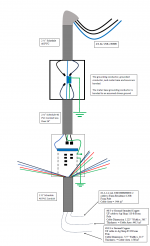ccrump
Member
- Location
- Northeast Georgia
- Occupation
- Teacher
The scenario I have been given is a 200 amp meter base that goes to a 200 amp main breaker panel. The neutral and grounds are bonded in the main breaker panel due to the being the first point of disconnect, since this panel will feed three subpanels. The meter base has a 6 awg that connects the grounding bus bar to the neutral/ground lug in the meter base. The grounding bus bar in the main panel goes to a 5/8 grounding rod at the bottom of the pole. The meter base also has a 5/8 grounding rod that has a seperate 6-awg bonding from it. Therefore, the meter base has a 6 awg that goes to the main breaker panel that has its own grounding rod, and the meter base also has another ground rod attached to it. However, the ground rods are not connected at the ground. Does this scenario seem up to code, and if not, why? Thank you for the help. This scenario is in an educational debate within my state and has been studied extensively with no concrete answers.

